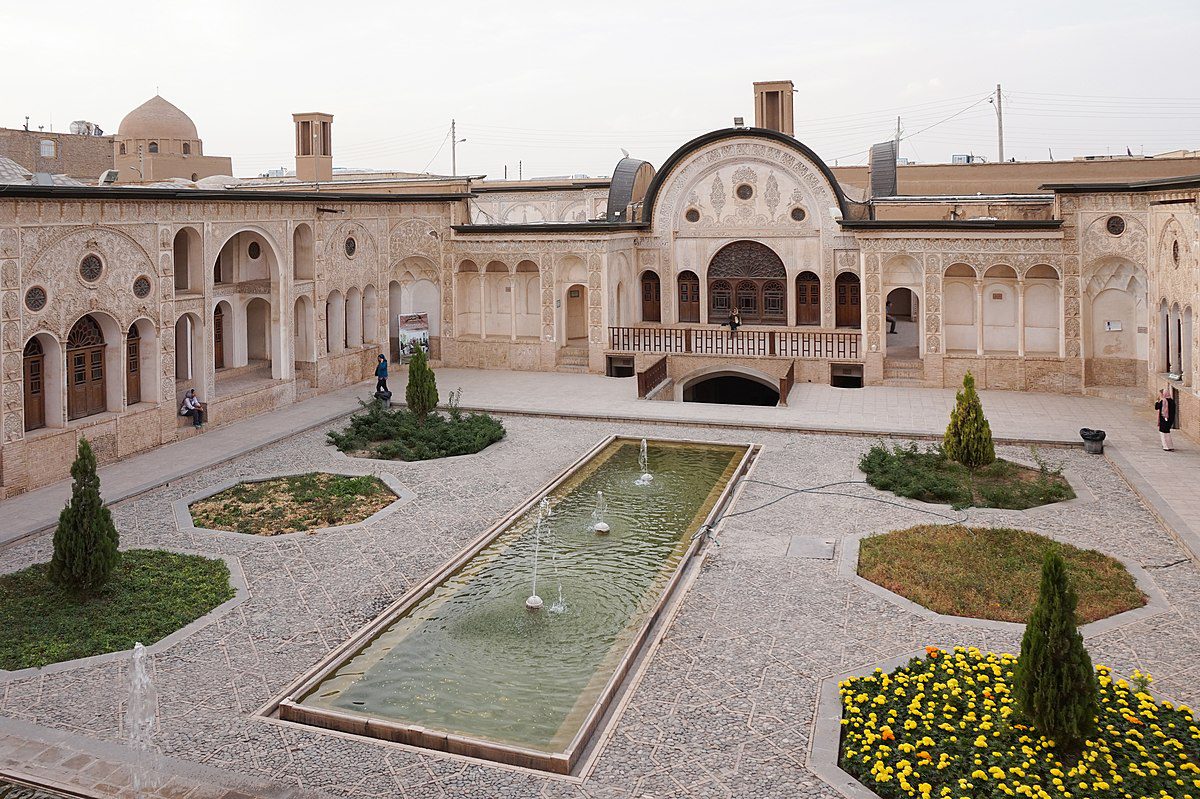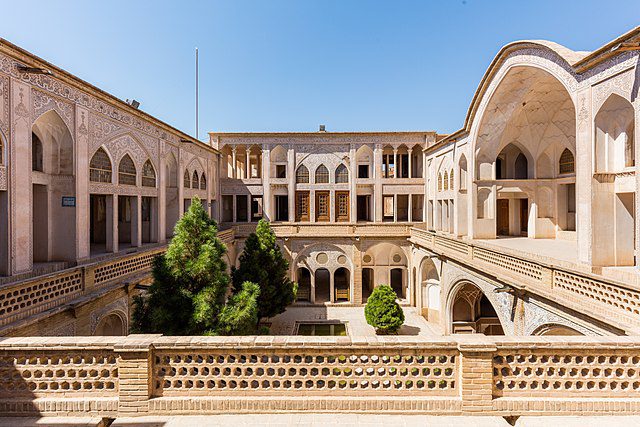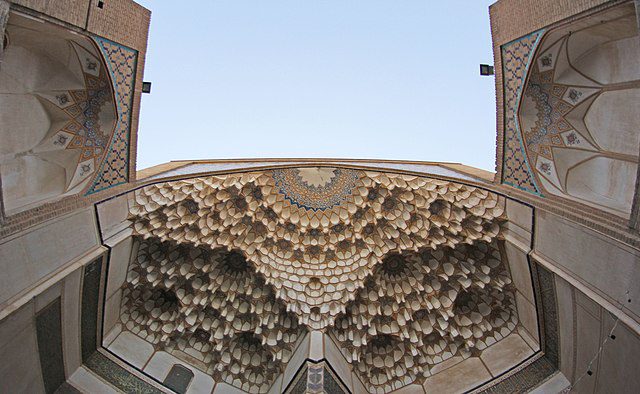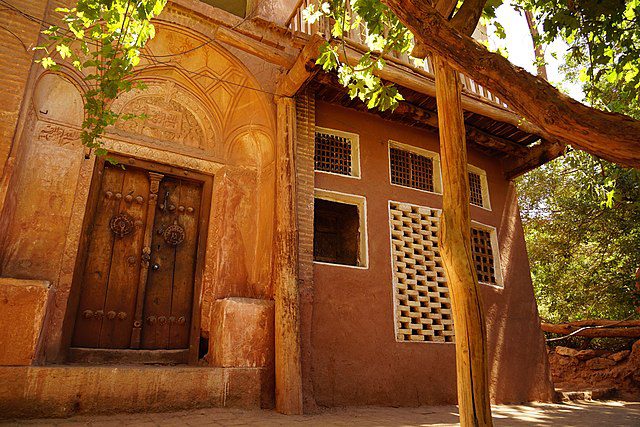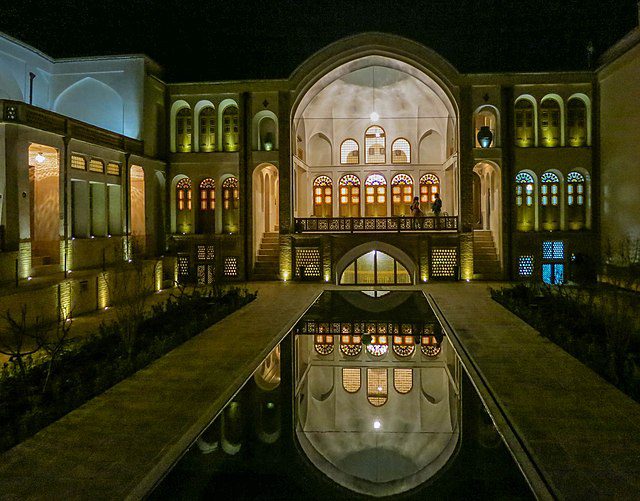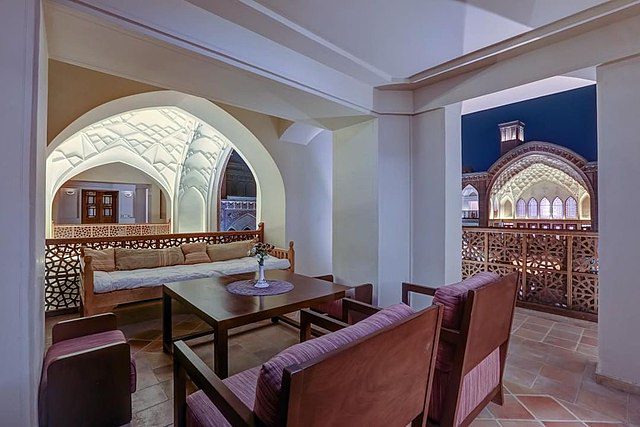Table of Contents
Kashan, a city in Iran’s Isfahan province, is a unique blend of history and beauty. It sits as the first oasis along the Qom-Kerman Road that stretches through the dry deserts of Iran. The contrast between the green, well-kept oasis and the surrounding arid landscapes gives Kashan its special charm. The Sialk Hillocks, found just 4 kilometers (2.5 miles) west of Kashan, hold ancient secrets, showing that this area was a hub of civilization long ago, even back to the time of the Elamites in Iran. The Sialk ziggurat, standing for 7000 years in Kashan’s outskirts, is a silent witness to this incredible history. This Kashan travel guide will give you a complete glimpse of the must-sees and dos of this historic city of Iran.
Kashan is a magnet for tourists who want to experience history firsthand. Visitors come to explore its old tales and see its ancient treasures. The streets of Kashan carry the stories of past civilizations, and the buildings reflect the skills of those who shaped its past. Walking through the city’s narrow pathways and bustling markets feels like stepping back in time, where the old ways blend seamlessly with the new. Kashan showcases a captivating mix of history and nature that leaves everyone in awe.
Weather and Climate of Kashan: From Blossoms to Breezes
When journey planning takes center stage, weather becomes your trusted companion. Kashan reveals a climate of contrasts. Its desert setting means chilly winters and hot summers. Unlike its neighbors Qom and Yazd, Kashan’s lower location adds its own touch to the weather waltz. So, in this ancient oasis, winter’s cool breeze and summer’s fiery sun play a unique duet, shaping the city’s vibrant character.
Spring in Kashan
March to mid-May is the time when Kashan flaunts its spring beauty. From May 5th to 15th, nearby Qamsar, Niasar, and Barzook come alive with rosewater festivals, a treat for the senses. Book early for accommodations and tours to secure your spot. If your visit coincides with Nowruz (March 20th to April 1st) or the Rosewater Festival, join in the festivities. Kashan’s spring is more than a season – it’s a chance to be part of its vibrant story.
Summer in Kashan
When summer heats up in Iran Kashan, June, July, and August aren’t the coolest times to visit. The city gets really hot and dry. But don’t worry – places like Niasar, Abyaneh, and Qamsar nearby have milder weather. Surprisingly, summer is when you can save money, as travel costs drop. So, while Kashan might be too warm, these nearby spots offer a cooler escape and a budget-friendly journey.
Autumn in Kashan
As summer bids farewell, Kashan dons its autumn cloak from September to November. The city’s weather turns mild, making it an ideal time to explore. With fewer crowds, you can savor the beauty in peace.
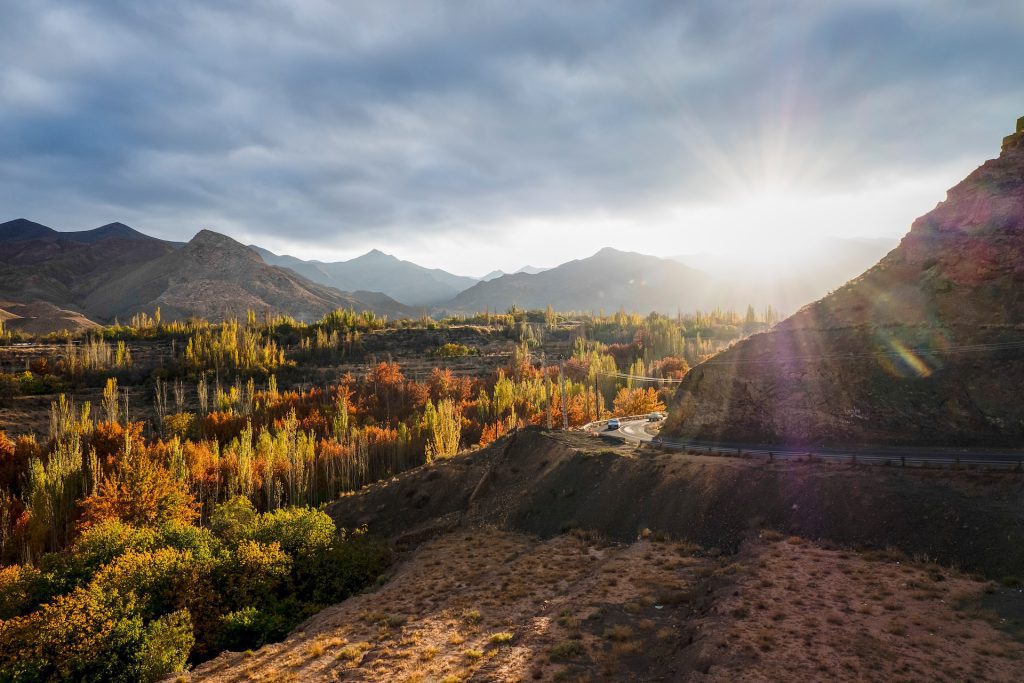
Abyaneh Village nearby becomes an enchanting getaway during this time, echoing autumn’s allure. For desert enthusiasts, fall is the prime season to camp under starry skies, surrounded by gentle desert warmth.
Adding to the season’s charm is the Mashhad Ardehal Carpet Washing Ceremony, a UNESCO-listed ritual. In September or October, Kashan and nearby towns gather for this ancient tradition, fostering a unique sense of community.
Embrace Kashan’s autumn – a serene blend of nature’s beauty, cultural moments, and tranquil exploration.
Winter in Kashan
When winter arrives in Kashan, the desert city gets cold and dry. From late November to February, it’s not the best time to visit. But if you’re looking to save money, this season is cheaper than spring and autumn. While the city might be less busy, it’s a chance to enjoy a quieter experience. Wander through historic streets and cozy up in traditional tea houses as the city’s pulse slows down, offering a unique perspective on Kashan’s charm.
Kashan’s Historical Houses: A Journey Through Time
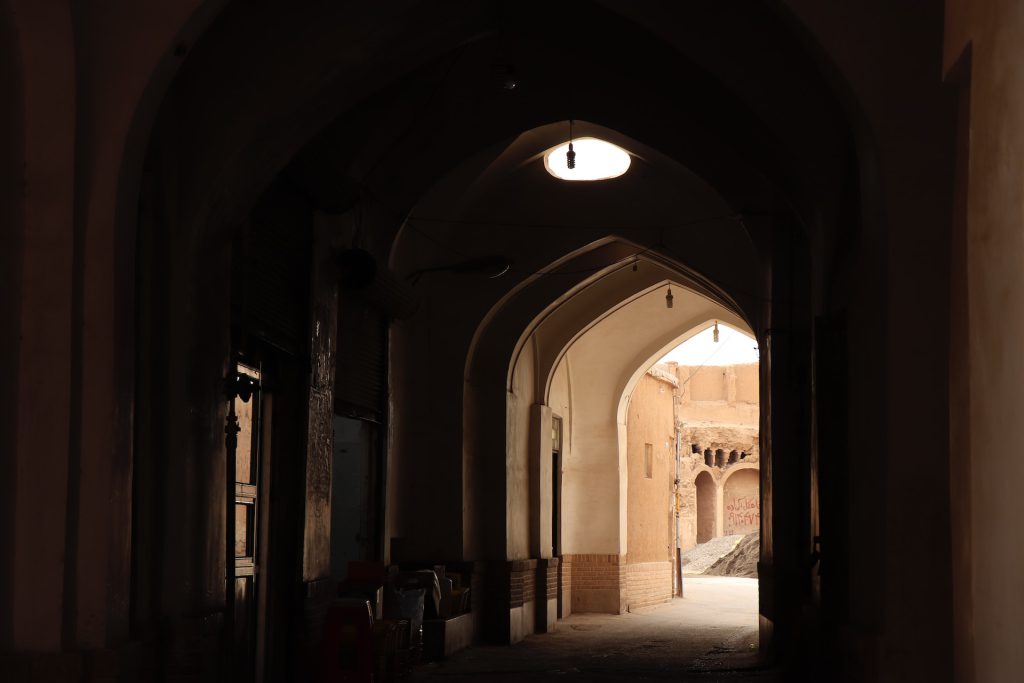
Kashan boasts some of the world’s most incredible historical houses. Each house here is like a unique treasure chest, holding special designs and architecture. Visiting Kashan is like taking a ride in a time machine, zooming back into ancient times.
These old houses are not just buildings; they’re like portals to the past. They show you how people used to build and live long ago. You’ll see lovely courtyards, colorful glass windows that play with sunlight, and wooden doors with fancy carvings that tell stories.
So, if you’re up for a journey through time, Kashan’s historical houses are ready to welcome you with open arms. Here’s the list of historical houses in Kashan:
Abbasi House in Kashan
Abbasi House isn’t just a home; it’s a spiritual haven. It took over 20 years to build this masterpiece during the 18th century for the Abbasi family. Spread across 7000 square meters, the house boasts five floors, six courtyards, and a main yard devoted to religious teachings.
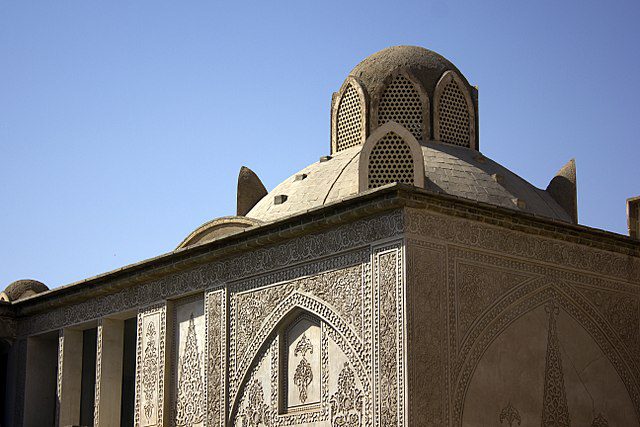
Cooling wind towers and fountains keep the historical house comfortable. The captivating “Shahneshin” room, adorned with mosaics, lets you feel like you’re beneath the sky. Abbasi House is more than bricks; it’s a tribute to history and spirituality, where every corner whispers the stories of the past.
Akhavan Historical House in Kashan
Unlike the typical traditional homes found in Iran, Akhavan Historical House stands out with its unique story. While it might not boast the same age as other historical houses in Kashan, it holds a charm of its own. Crafted by an Iranian architect and later acquired by Persian entrepreneur Babak Akhavan, this dwelling serves as a captivating testament to the fusion of modern and traditional architecture.
In a landscape where history often dictates design, Akhavan Historical House dares to embrace innovation. Its narrative unfolds through its distinctive blend of architectural styles, inviting you to witness the harmony that emerges when modern sensibilities intertwine with age-old traditions.
Ameri House in Kashan
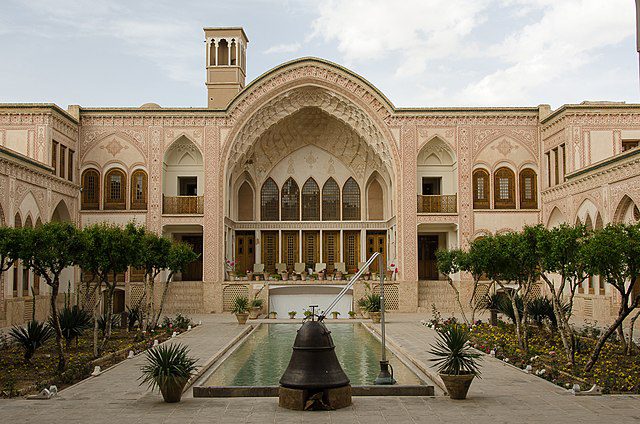
Discover the grandeur of bygone days at Ameri House, the largest historical residence in Kashan. This splendid abode was originally built for the city’s governor during the Zand dynasty, and though it faced ruin from an earthquake, it emerged anew in the 19th century.
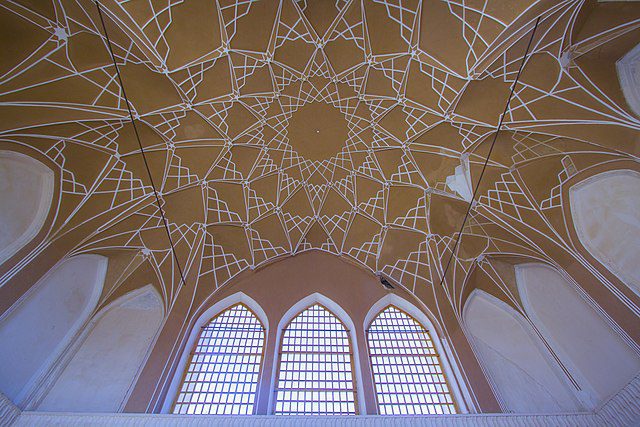
Within Ameri House’s walls, you’ll find a labyrinth of 85 rooms, seven serene courtyards, and two lavish bathhouses. The interiors are a true feast for the eyes, adorned with intricate tilework, vibrant paintings, and glistening mirrors. Amidst this architectural marvel, the towering wind towers stand tall, lending a touch of coolness to the air. Situated in the heart of Kashan’s neighborhoods, Ameri House invites you to delve into its history, nestled conveniently near attractions like the Bozorg Mosque and the Toy Museum.
Heshmatullah Khan House in Kashan
Imagine going back really, really far, to the time when Qajar was a thing. That’s when Heshmatullah Khan House was built. This house is pretty special – it’s got a big yard right in the middle. And guess what? There are some super important parts of the house. There’s a fancy room for important people, a place to keep water, a section with seven doors (they call it Haftdari), and a nice porch at the entrance. But the Haftdari part is the star – the entrance is more than eight meters wide, bigger than any other old house in Kashan.
Now, fast forward a bit – the house got a makeover thanks to the people who care about old stuff. They fixed it up and even connected it to another old house called Ameri House. When you step inside, it’s like you’re not just visiting; you’re like a time detective, discovering all the stories hidden in its walls.
Borujerdi House in Kashan
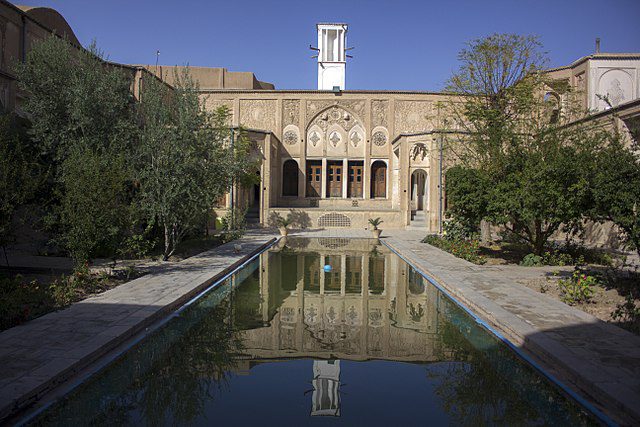
In the heart of Kashan, a love story unfolds through the artistry of Borujerdi House. Seyyed Mehdi Borujerdi, enamored with a girl from a prominent family, enlisted architect Ali Maryam to craft this stunning mansion. With over 150 skilled workers, they brought to life a symbol of devotion.
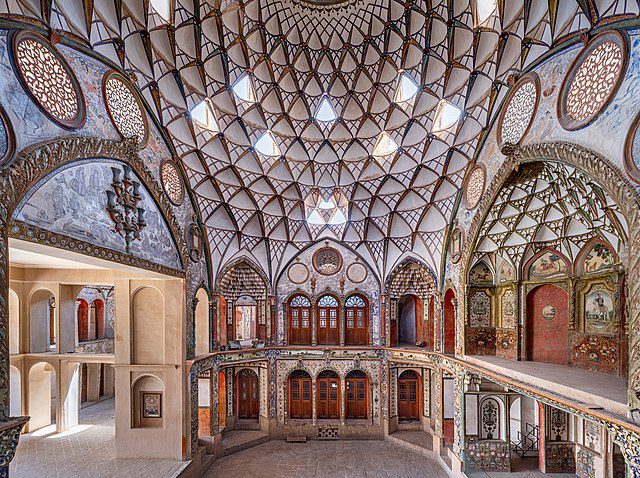
Borujerdi House is a testament to love’s power. Recognized by UNESCO, it’s hailed as Asia’s most splendid home. The outside blends traditional Iranian style with elegance, while inside, intricate paintings and carvings tell stories of the past. To truly grasp its magic, one must step inside and feel the history and passion that infuse every corner. This is a place where love became architecture, a tale waiting for all to explore in Kashan.
Razzaqian House in Kashan
Imagine going back in time to when Qajar was a thing, and you’ll find Razzaqian House in Kashan. This house is like a treasure chest of old stories. It’s got places inside and outside, and there are two open areas – one inside and one outside – on both sides of the house. Right in the middle of the inside and outside parts, there’s a fancy room that kings and queens would like.
But wait, there’s more! This house is like an adventure playground. There’s a special spot for when the weather gets warm, and something called windcatchers that bring in nice breezes. Imagine walking around, feeling the cool air from the windcatchers, and hearing the stories the house wants to tell. It’s like you’re inside a really old picture, seeing how things were a long, long time ago.
Tabatabaee Historical House in Kashan
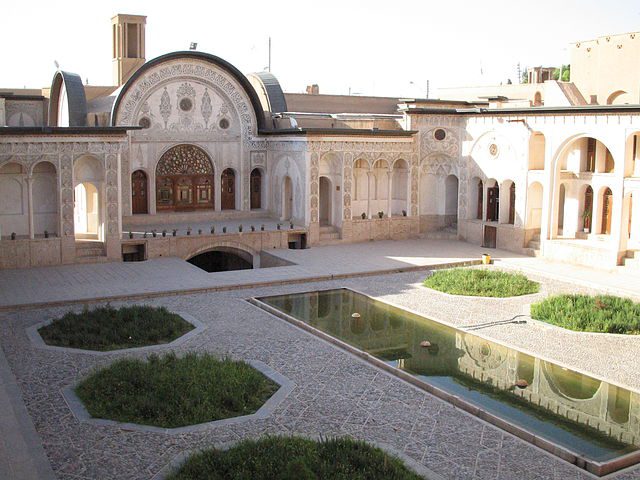
Step into Tabatabaee Historical House in Kashan and be transported to a time of grandeur. Designed by architect Ali Maryam, who also crafted Borujerdi House, this masterpiece was a gift from carpet merchant Seyed Jafar Tabatabaee to his wife.
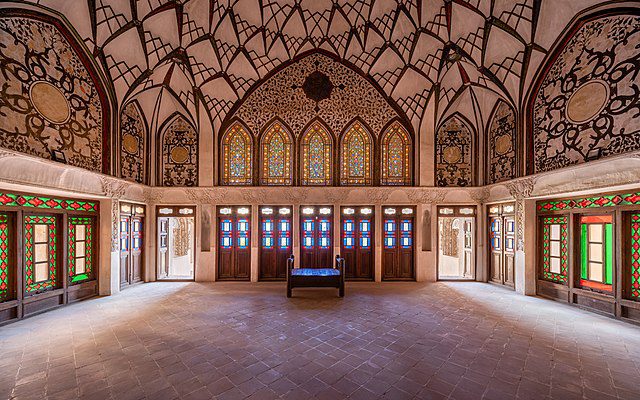
Wander through Tabatabaee House’s four courtyards, adorned with intricate wooden doors and windows. The highlight? A colorful lounge, where sunlight paints enchanting hues, etching an everlasting memory. Beyond beauty, the house is smart too. With Kashan’s hot summers in mind, it boasts three “Badgir” wind towers. These ancient air conditioners cool the entire place, merging elegance with ingenuity.
A visit here is a journey through history, where art and architecture blend. Each corner tells a tale, capturing the essence of a bygone era.
Sharifian House in Kashan
Among the celebrated historical treasures of Kashan, Sharifian House holds a place of honor. Rooted in the Qajar dynasty, this architectural gem offers a journey through time. At its heart lies a captivating pond, adorned with quintessential Persian embellishments, casting a spell of enchantment.
A true embodiment of Kashan’s historical dwelling, Sharifian House unfolds in two distinct realms: the inner sanctuary (andarooni) and the outer realm (birooni). Within these walls, the past whispers its tales, and every corner bears witness to the finesse of a bygone era.
Intriguingly, respect for religious beliefs and traditions is etched into its layout. A conscious division prevails: the inner sanctum is devoted to women and servants, hidden from the prying eyes of guests. This reverence for privacy and cultural customs reflects the intricate tapestry of Iranian life, where history and values intertwine seamlessly. Sharifian House beckons, not just as an architectural marvel, but as a living canvas of a time when every detail spoke volumes about heritage and honor.
Things to Do in Kashan: Top Kashan Attractions!
Kashan’s beauty and charm have become pillars in shaping Iran’s tourism landscape. Today, we embark on a journey to uncover the finest experiences this city offers. Yet, as you traverse its cobblestone paths, know that Kashan is no relic. Despite its millennia-spanning existence, the city wears its history gracefully, its traditional and historical essence a captivating backdrop to modern life.
With every step, you’ll find yourself walking through the pages of time. From bazaars echoing tales of trade to grand architecture whispering stories of dynasties, Kashan is a living testament to its own legacy. Here’s the list of top attractions in Kashan:
1. Fin Bathhouse of Kashan
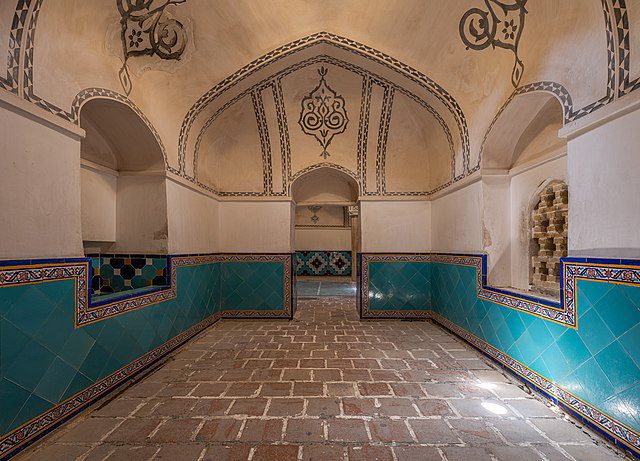
People remember Fin Bathhouse not just for its history, but for a story about Mirza Taghi Khan Amirkabir. He was a big politician in Iran’s past. This unique bathhouse is inside Fin Garden.
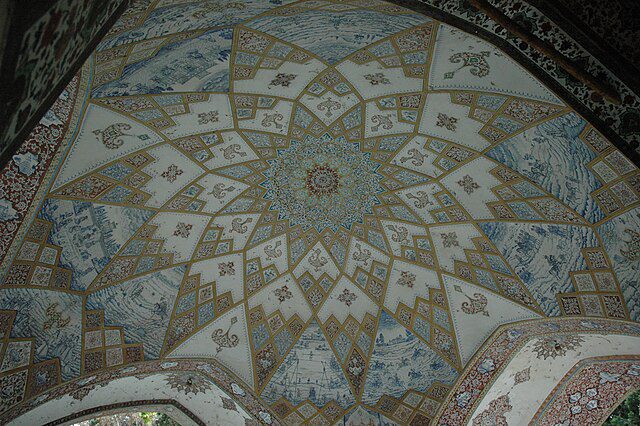
Surrounded by 579 cypress trees and 11 sycamores, Fin Bathhouse is in a very pretty place. The garden is near Sulaimaniyah Spring and the end of Amirkabir Street. It makes this part of the city feel cooler and better. The Fin Bathhouse stands tall among very old trees. Some of the trees, like cypress and sycamores, are more than 100 years old. A few are even 470 years old! Besides its old beauty, more things were added to Fin Garden after the Safavid time. There’s a royal room, Karimkhani privacy, the national museum, and the royal bath.
In 2011, Kashan’s Fin Garden became part of the UNESCO World Heritage List. This means it’s really important and worth seeing.
2. Qamsar
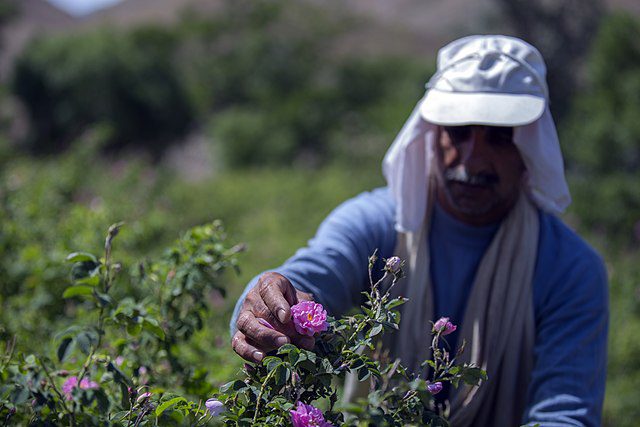
When you visit Kashan during the rose-picking season, a remarkable experience awaits you in the town of Qamsar. Qamsar becomes an extraordinary place during this time, as the landscape is painted with the hues of pink damask rose farms, infusing the air with their sweet scent.

Qamsar attracts travelers from around the globe who come to partake in the joyous rose-picking ritual and the art of crafting rosewater. As the petals are collected, the process of making fragrant rosewater begins. This skill has made Kashan’s rosewater renowned, not only within Iran but across borders.
A visit to Qamsar reveals the enchanting side of Kashan, a city woven with the threads of rosewater tradition. As the world gathers to witness the rose-picking ritual, it’s a chance to immerse oneself in a unique cultural experience that transcends borders and leaves an indelible memory.
3. Sohrab Sepehri’s Grave in Kashan
In Kashan, the great poet, painter, and writer Sohrab Sepehri found his final resting place. Born here, his influence continues to shine in Iran’s creative world. At 52, Sepehri passed away and was laid to rest in the courtyard of Imamzadeh of Sultan Ali Ibn Mohammad Baqir in Mashhad-e Ardahal, part of Kashan. His grave was adorned with turquoise tiles, though time turned them black.
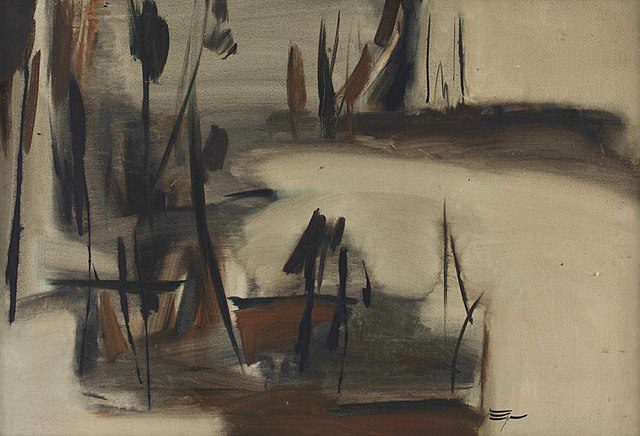
Sepehri’s tombstone stands as a tribute to his impact. His work still resonates, making this a meaningful visit to an artist’s eternal abode. It’s a journey into the heart of creativity. In the Imamzadeh of Sultan Ali Ibn Mohammad Baqir, Sohrab Sepehri’s legacy lives on. His art and spirit remain, reminding us of the enduring power of creativity.
4. Tepe Sialk in Kashan – Sialk Hills
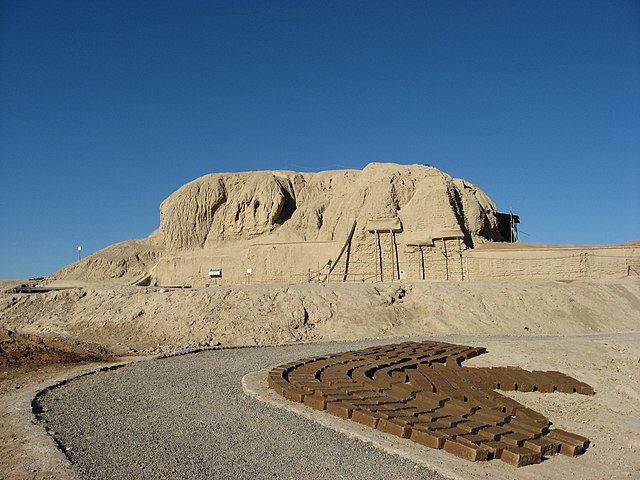
In Kashan’s Fin neighborhood, stands Sialk Hill, an ancient mound revealing Iran’s earliest days. This hill, around eight thousand years old, echoes the footfalls of Central Iran’s first settlers. Once cave-dwellers, they embraced farming after climate shifts, evolving a civilization that outshone others in progress. Tools and artifacts unearthed here speak of these pioneers’ lives.
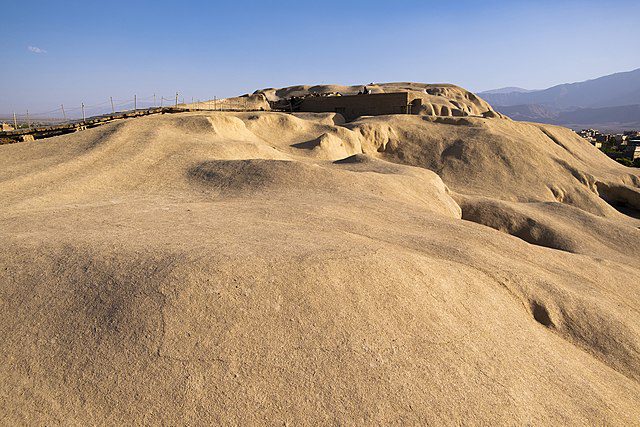
Scaling Sialk Hill’s gentle slopes, you’re embarking on a journey bridging ages. Millennia ago, these grounds witnessed a shift from caves to farming, a leap into progress. Artifacts tell the story of this transition – a vivid snapshot of their resourcefulness.
Sialk Hill isn’t just relics; it’s a haven of calm, where history converges with serenity. Stand on its peak, and you’re embraced by an unmatched peace, a whisper of ages past. The wind seems to echo the stories of old, inviting you into the fold of history.
If delving into ancient history calls to you, Sialk Hill beckons. Feel the soil underfoot, where once ancient hands toiled. It’s not just a place; it’s a passage to Iran’s roots, an unmissable journey through time’s corridors.
5. Khorramdasht Fire Temple
Go to Khorramdasht village and find something very old – the Khorramdasht Fire Temple. It’s from a time called Sassanid, a long time ago, and it’s like a window into history. This temple is made from strong things like stone and plaster. It’s like another building in Niasar called Chahartaq. They look alike.
When you step inside the Khorramdasht Fire Temple, you might feel the people who were there long ago. It’s like a peek into their special ceremonies and what they believed. Explore the Khorramdasht Fire Temple and you’re taking a trip to the past. It’s like a story waiting to be discovered – a place where ancient stories and beliefs come to life.
6. Kashan Traditional Bazaar
Kashan’s Traditional Bazaar is a special place with old stories. It starts from Baba Afzal Street and goes to Darvazeh Dowlat Street. You’ll see old buildings like Mir Panj Caravanserai and Timcheh Amin al-Dawla.
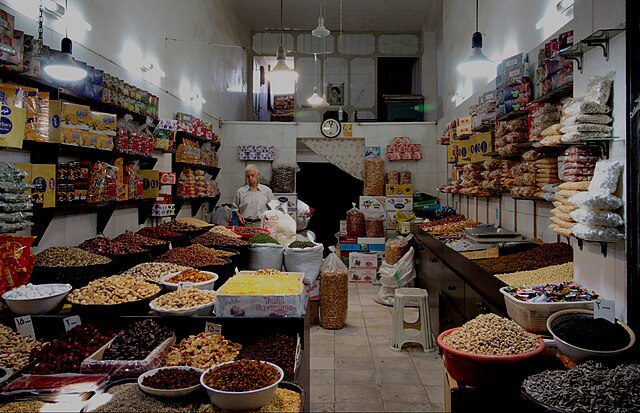
When you walk around, you’ll find different parts for different things. One part has people who make things from copper, shoes, and colors. Another part has people who make things from gold and clothes. And don’t forget to try the yummy sweets that people love from here.
Walking in this bazaar is like going back in time. You’ll feel history all around you and see many colorful things. This bazaar is not just a place to buy things, it’s a way to connect with how people used to live.
7. Sultan Amir Ahmad Bathhouse
Step into the past at the Sultan Amir Ahmad Bathhouse, a remarkable vestige from the time of the Seljuk dynasty. Nestled beside the Sultan Amir Ahmad Imamzadeh, the bathhouse derived its name from this close proximity. While the Qajar period witnessed its renovation, the bathhouse’s origins trace back to the Seljuk era.
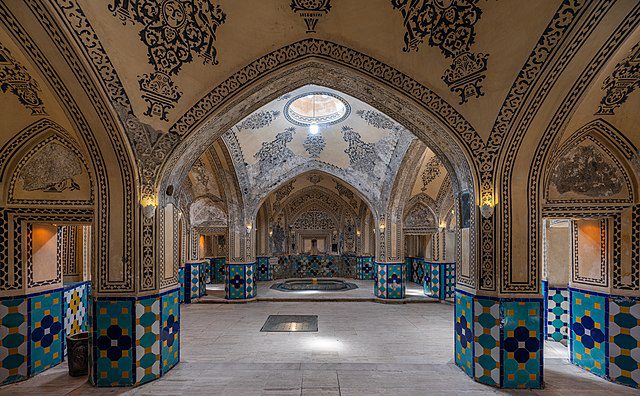
Within the bathhouse’s intricate architecture, two distinct bathing areas await: a spacious chamber and a more intimate one. These baths served as weekend retreats, welcoming visitors to unwind and indulge in the soothing waters. Yet, beyond its function, the bathhouse boasts architectural wonders that transport visitors to a time of grandeur.
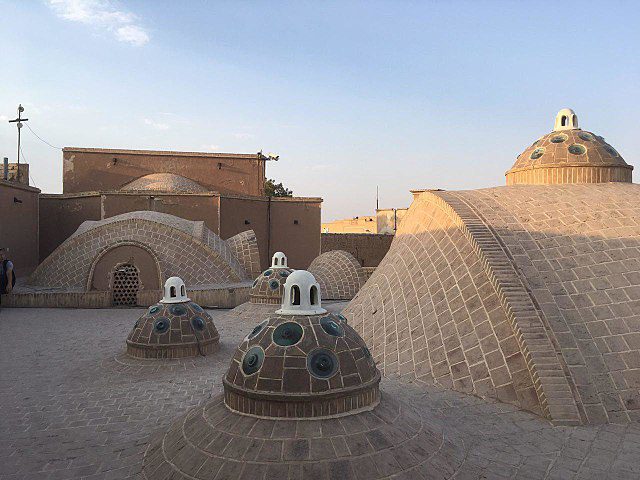
The crowning jewel of the Sultan Amir Ahmad Bathhouse is its dome-shaped roof, a masterpiece that graces our nation’s architecture. This dome is adorned with a unique feature – a convex lens set within the glass, allowing soft daylight to flood the interior. This ingenious design not only illuminates the space but also safeguards the privacy of its occupants. As you stand beneath this radiant canopy, you’re reminded that history’s treasures often lie in the most exquisite details.
Exploring the Sultan Amir Ahmad Bathhouse is like peeling back layers of time. Amidst the captivating surroundings, you’re transported to an era of opulence and relaxation. With its resplendent dome and thoughtful design, this bathhouse beckons you to experience the intersection of architecture, history, and serenity.
8. Agha Bozorg Mosque of Kashan
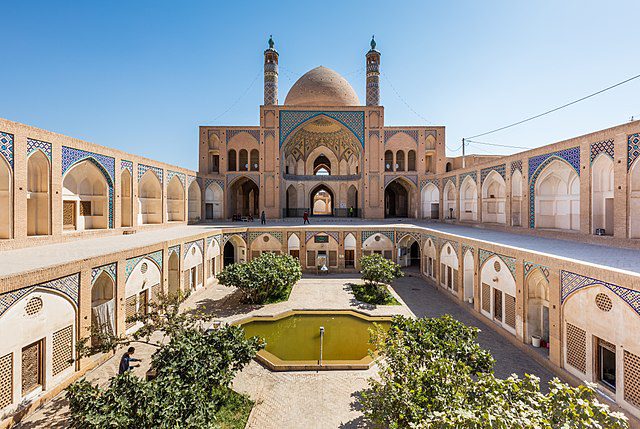
Travel back to the Qajar period through the Agha Bozorg Mosque and school. It took about eight years to build this treasure, a reminder of times long ago. Look up and admire the mosque’s big, clay dome – one of the largest in Iran. It’s like a crown atop the building. You might notice the mosque’s style is a bit like the Chaharbagh and Sadr schools in Isfahan.
Walking into the Agha Bozorg Mosque is like stepping into an old painting. The past comes alive here, telling stories of a different time.
9. Niasar Cave of Kashan
Close to Niasar village stands the ancient Niasar Cave, a marvel that’s been around for 2000 years. What makes it special? It’s not natural – people made it. Inside, you’ll find twisty stone paths, like a maze. Experts think it was used for important religious things because of how it was built.
Long ago, this cave might have been a place for religious ceremonies linked to Mehr and Mithra. Water was important for these ceremonies, and the nearby Niasar Waterfall fits into this story. This cave could’ve been a place for people who followed these old beliefs.
Step into the world of the Niasar Cave, where history comes alive. It’s like a bridge between the past and now, where you can imagine the rituals and beliefs of people long ago.
10. Noushabad Underground City
Underneath the town of Noshabad, there’s a hidden place called the Noushabad Underground City, or Ouyi City. It’s been around for a long time before Islam, keeping its history a secret. This city has three levels under the ground. Inside, there are many paths, rooms, and waterways. They connect the levels with wells that go up and down.
People built Ouyi City for different things, like protecting themselves during wars. It’s about four kilometers wide and is 4 to 16 meters deep in different places. This place is like a huge tunnel, the biggest underground city ever made, used for many different things. When you explore the Noushabad Underground City, you’re traveling through history. It’s like a journey into the past, where you can imagine what life was like in those hidden tunnels.
11. Tomb of Khajeh Tajuddin in Kashan
In Kashan, the Tomb of Khajeh Tajuddin stands close to the Aghabzorg Mosque, a historic treasure that whispers tales of the past. Once a grand complex with a school, monastery, water reservoir, and mosque, now only two domes and the monastery remain. Back in the ninth century, during the Aghquyunlu era, Khajeh Tajuddin Shirvani, along with his brothers, shaped Kashan’s skyline with remarkable buildings, two of which survive as this mosque and monastery.
Tourists are drawn by the intricate architecture, adorned with stunning tiles, and the alluring decorations inside the tomb. It’s not just a monument; it’s a glimpse into the soul of a city’s history, waiting to be discovered.
12. Soltanieh School in Kashan
Back in the old days in Kashan, they built a special place called Soltanieh School. It was during the time of Fath Ali Shah Klang, around 1806. The building work took about 8 years, and it was finished in 1814, thanks to an architect named Mohammad Shafi. You can find this school not far from Kashan Bazaar. It’s kind of similar in style to other schools in Isfahan, like Chaharbagh and Sadr.
Imagine a place with pine trees and a fountain in the middle – that’s the Soltanieh School courtyard. All around, there are about 50 rooms where students used to learn. The walls have pretty designs, and the roofs are made from special bricks. The entrances are fancy with colorful tiles, making tourists really interested to see. Walking around here is like stepping into history – it’s like magic that connects the past to now.
13. National Museum of Kashan
Imagine entering a place where the past speaks to you through stuff on display. That’s Kashan National Museum, one of the oldest museums made to keep history alive. Inside, you’ll find about 400 things that tell stories from way back in 700 BC till now. The people in Kashan helped find these things. The museum is about as big as 700 square meters – not too big, not too small.
This museum has two floors: one on the ground and one below it. Most of the cool stuff is on the ground floor. You start by looking at things dug up from the past, like ancient tools and stuff. Then you move through time, seeing things people make now.
The building itself is really like Iran – it has a special roof with a round part on top and four glass things to let sunlight in. On the walls, there are words carved into stone. One says when they built the place, and the other says “Kashan National Museum started in 1346,” which is just another way of saying 1968. These words are like the museum’s name tags, telling you who it is.
14. Maranjaab Caravanserai
Let’s travel back to a long time ago, during the Safavid time, and find the Maranjaab Caravanserai – a special place in Kashan. A famous person named Shah Abbas said, “Build it!” And so, they did. This place is like a big strong house, almost like a castle, because it kept people safe when bad things happened. When the Uzbeks came to fight, around 500 soldiers stayed there. They made it from strong bricks and plaster, and up top, there are tall parts where they could look around.
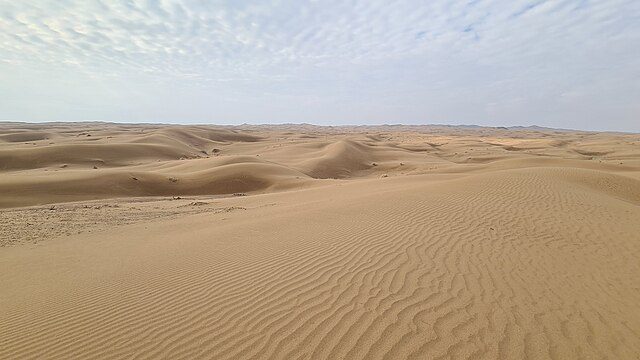
Now, let’s go to the Maranjab Desert in Kashan. Right in the middle, there’s this beautiful caravanserai from a very long time ago, when people traded on the Silk Road. Even though it’s really old, it still lets people stay inside. And guess what? There are cozy places nearby where you can sleep too. So, if you’re up for a little adventure, you can sleep in one of those comfy places and explore the caravanserai’s secrets. It’s like going back in time and feeling what it was like for those who traveled long ago.
15. Jalali Castle of Kashan
Deep within Kashan, there’s a piece of history that whispers tales of the past – the Jalali Castle. The city’s heart holds on to remnants of strong Seljuk walls, but only two remain, standing tall like time travelers. Thatch was their maker, long ago in the eleventh century.
Imagine Khajeh Majdaldin Abolghasem Kashani, a powerful figure in the Seljuk times, laying the foundation of this historical shield. It’s said these walls kept Kashan safe from enemies, like a shield against attacks and plundering.
Right by these ancient walls, a piece of a castle remains. Stories say it was built by Sultan Jalaluddin, a Seljuk king. This castle wasn’t just any place – it was the government hub for a while. Together with the Seljuk walls, the Jalali Castle creates a unique blend of history, a piece of the past that’s still here, whispering its tales to those who listen.
16. Kashan Gabrabad Bridge
Right in the middle of Kashan, there’s an old bridge called Gabrabad. It’s from a long, long time ago when things were different – the Safavid era. The bridge is in a village with the same name, Gabrabad. It’s been so important that since July 2005, it’s been officially recognized in Iran as something really special, like a treasure from the past.
So, when you walk on this bridge, you’re like a time traveler, walking where people from a very long time ago once walked. Every stone is like a page from an ancient story.
17. Mir Emad Mosque
In the busy part of Kashan called Bazaar, there’s an old place known as Mir Emad Mosque. It’s also called Meydan Mosque because ‘Meydan’ means square in Persian, and it’s right in front of Bazaar Square. Imagine, it was made a really long time ago, in the year 464. Someone named Khajeh Amir Emad al-Din Shirvani made it happen.
Now, let’s peek inside. This mosque isn’t just one thing – it’s got a special porch, a yard with two stories, a place to sit, a dome on top made from bricks, a place called a pulpit, a spot to keep water, and not one, but two doors with writing from way back when. Outside, there’s a big rock with important words on it. If you read these words, it’s like opening a door to the past. You learn about how things were a long, long time ago – like a peek into people’s lives and what they thought was important. It’s like a secret note from history.
18. Seyyed Zia-ol-Din and Qadamgah-e Hazrat-e Ali
Kashan holds secrets of its past in the form of old religious places that tell stories of the city’s beliefs. Two of these special places, Seyyed Zia-ol-Din shrine and Qadamgah-e Hazrat-e Ali, take us back to the time of the Seljuk era. These places are like a window into history.
Imagine visiting the Seyyed Zia-ol-Din shrine. There’s no dome on top, but as you step inside, you’ll see a wooden structure covering Seyyed Zia-ol-Din’s resting place. And guess what? Qadamgah-e Hazrat-e Ali is just a short walk of one hundred meters away.
Look around, and you’ll see amazing architecture that shows the art taste of people from long ago. This shrine isn’t just a place to pray; it’s also a piece of history and art. When you visit, take your time to see all the beauty and amazing things it holds. It’s like going back in time and feeling the stories of the people who lived there.
19. San San Caravanserai
Imagine a pretty place called San San Caravanserai with special Iranian looks and nice designs. It’s really old, from the Safavid time, a long, long time ago. If you go about four kilometers from Qom-Kashan Road, you’ll find it. It’s like a secret between two villages, Ab Shirin and Meshkan.
Look at it, and you’ll see a place with four porches around a square yard. Can you believe they made it from mud, clay, and bricks? People from Rey City and Qom loved to stop here, like a cozy spot on a journey. And guess what? This old place has been important since 1985 when it was put on Iran’s special list. It’s like a piece of history that’s still here today.
20. Zeyn od-Din Minaret
A super old tower called Zeyn od-Din Minaret in Kashan is like a time machine from long, long ago, between the 11th and 13th centuries. A person named Khajeh Zeyn od-Din made this tower happen. But here’s the thing – people aren’t sure exactly when it was built. A long time ago, someone named Madame Diolafova said it’s from the 13th century, which is when the Ilkhanid time happened. But to really know, you have to study really, really carefully.
Now, this tower is kind of a big deal in Kashan’s history. It’s made from bricks and has these cool blue tiles. If you look up, you’ll notice the top part isn’t there anymore, so no one knows how tall it used to be. But old books from a really long time ago, during the Qajar time, say it might have been about 47 meters tall.
Inside this tower, there’s a spiral set of stairs that goes up. But inside, it’s not all fancy. At the tippy top, there used to be a little room where people could look around and tell important news to everyone. If you peek down at the bottom, there’s an old writing that’s been through a lot. Over time, nature and not-so-careful people have made it hard to see.
This old tower is so special that it’s been on Iran’s list of important things since way back in 1932. It’s like a piece of really old history that’s still standing strong today.
21. Abyaneh Village
Abyaneh Village is really high up, one of the highest in Iran. It’s a special place with a calm feeling and great views. If you need a break from normal life, go to Abyaneh. When you come to Abyaneh, you’ll see houses and buildings that look different, and the air is fresh and nice. There are lots of old things to see, and you’ll forget about everything else.
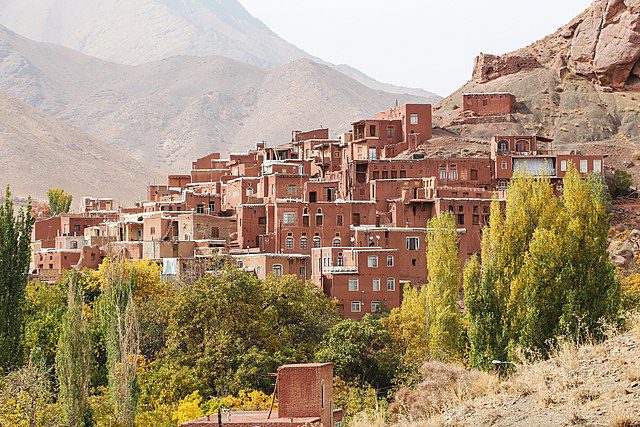
Abyaneh Village is built on a steep hill next to a river. The houses have wooden windows, and they’re covered with red dirt. People here wear traditional clothes that might surprise you. All of this makes Abyaneh a really nice place for tourists.
When you walk around Abyaneh Village, you’ll feel like you’re in a story from the past. The old streets, the colors of the earth, and the friendly people make you feel like you’ve traveled to a different time.
22. Kamal-Almolk Village
A little village named Kamal-Almolk, far away, about 40 km to the northeast of Kashan is like a tiny town on a hill, close to a special place called the Sultan Ali holy shrine. A long, long time ago, some really important people lived in this village.
The village has another name, Kaleh, but what’s cool is that it’s known for being a smart place where people learn and know a lot of things. And guess what? There are old things there, like buildings that have been around for a really, really long time. These old buildings are mixed with how pretty the village is, and it all makes for a really nice view. Oh, and don’t forget about a special place called Qadamgah-e Hazrat-e Ali – it’s got its own story too. When you’re in Kamal-Almolk, it’s like stepping into a story that’s been told for a super long time.
23. Van Village
A village named Van, nestled in the middle of a green plain is like a colorful painting, untouched and pure. The name comes from the van trees that used to fill the village. In the past, there were lots, but now only a few stand strong. The people here have their own language and traditions, making it a unique place.
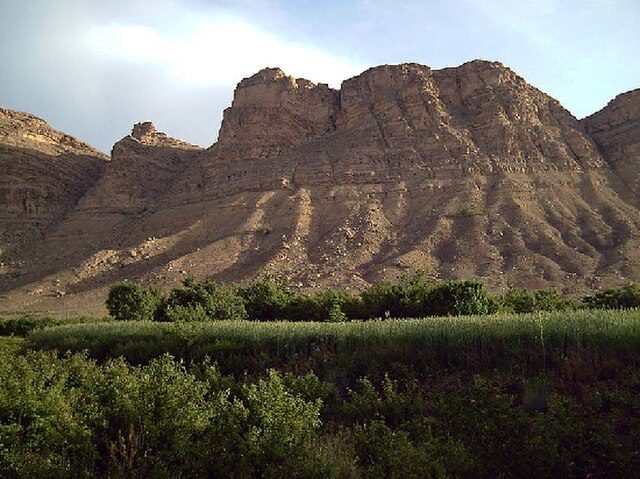
As you walk around, you’ll find old things that tell stories – the village’s history is right there in front of you. While seeing them is great, hearing about their tales will be a highlight of your visit. This village has seen over a thousand years, a living relic of the past. Don’t forget to try the local food in their restaurants. It’s like a taste of tradition, adding a flavor of authenticity to your trip.
24. Azeran Village
Imagine a village up in the mountains, Azeran. It’s about 72 km from Kashan city. The Karkas mountains make it really pretty. The weather is nice in spring and summer, but winter gets really cold. People here take care of animals, farm, and make carpets.
In Azeran Barzak, they grow Damask roses that make the village beautiful. And guess what? Springs keep everything cool and refreshing. There are plants for medicine too. People visit for that.
The folks speak their own language and keep their old ways. When you visit, you’ll feel it. The village’s charm, friendly people, and how they welcome you – it’s like a warm hug. Imagine after a long road, you’re here, and all the tiredness goes away. They’ll give you a drink or milk. You can sit on their mats or gather around their warm spot in winter. It’s like a different world where nature and tradition meet to make you feel at home.
16th Century Silk Carpet of Kashan: Threaded Elegance!
Journey back in time to the 16th century, during the rule of the Safavid dynasty, and discover the origins of Kashan Silk Carpets. This was when the city of Kashan was a bustling center for crafting top-notch silk and wool rugs. The carpets of that era were known for their intricate designs, fine weaving, and tightly-packed knots.
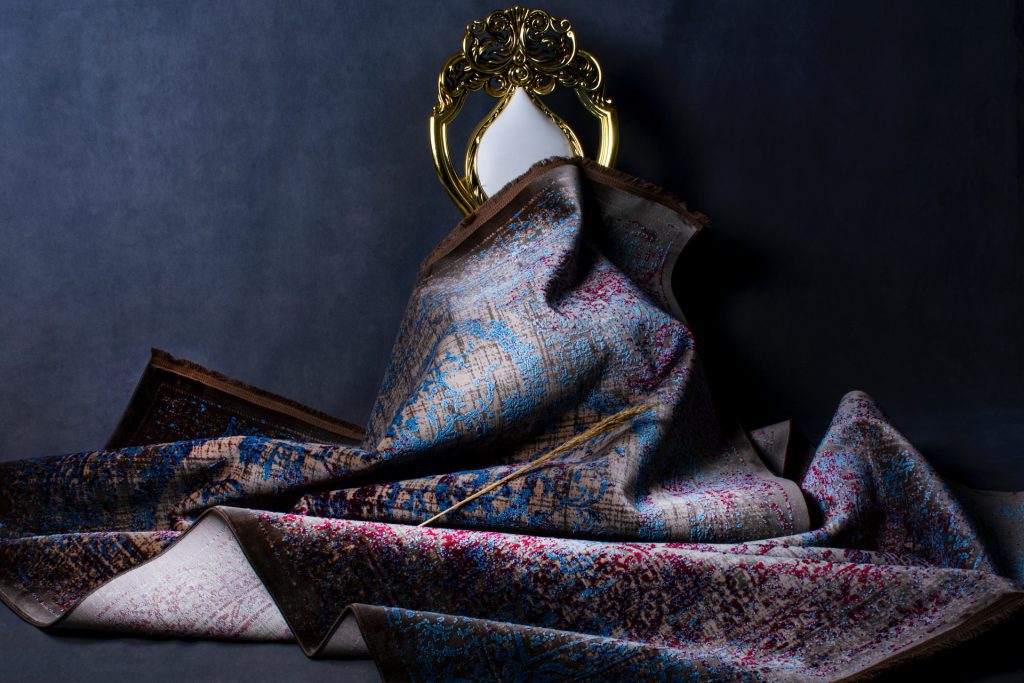
Imagine the looms of Kashan in action, weaving together a tale of artistic dedication. These early carpets weren’t just woven; they were a manifestation of the weavers’ skill and passion. The threads came together in delicate patterns, forming a carpet dense with knots. Each knot was a mark of the weavers’ commitment to quality. Today, Kashan Silk Carpets stand as living relics of this heritage, preserving the city’s reputation for sophistication and craft.
Best Restaurants in Kashan: Dining Back in Time
Kashan is a city where history lives on in old streets and ancient houses. Kashan’s old houses have been turned into restaurants. These places offer more than just meals; they give you a glimpse into the past. Whether you want fancy or cozy, quiet or lively, Kashan has it all.
Take a stroll through the city and discover these special spots to eat. Each one has its own unique flavors, ready to delight your taste buds. Kashan isn’t just about history – it’s a feast for your senses. Here’s the list of the best restaurants in Kashan:
Manouchehri Restaurant
Step into history at Manouchehri House, an ancient treasure in Kashan. Once a home, now a hotel, restaurant, and a must-see for tourists. In the heart of Manouchehri House, the restaurant shines with elegance. The restaurant serves up a menu full of classic Persian dishes. You can’t leave without trying the local favorite, “Khoresht Nokhod Alleh.” Indulge in history and luxury at Manouchehri Restaurant, where every bite tells a tale of the past.
Saraye Ameriha Restaurant
Step back in time to Saraye Ameriha, an old home turned into a stunning boutique hotel. Imagine a hall covered in mirrors, crafted by Kashan artisans centuries ago. Despite the traditional vibe, the restaurant is luxurious, so be sure to book ahead. On the menu, you’ll find only classic Kashan dishes like “Kofte Ab Somag,” Abgosht Lobia, and Gosht Lobia. These dishes come at a higher price, but the taste and memories are worth it.
Morshedi Restaurant
Want genuine vibes and tasty food without the big bill? Morshedi House Café & Restaurant is your spot. In the old Morshedi house, you’ll feel the charm even though it’s not the fanciest. Imagine eating these special treats from clay dishes, with local Doogh and fresh veggies – a flavor combo that’s sure to make you smile. And don’t forget, there’s a cute café right next door. Morshedi Restaurant isn’t just food – it’s a dive into tradition, where each bite tells a tale.
Mahinestan Raheb Restaurant
Mahinestan Raheb Hotel marries tradition and modern comfort, making it Kashan’s top traditional stay. Its restaurant is a must-visit for travelers. Popular dishes like Tas Kebab, Gosht Lobia, Khoresht Nokhod Alleh, and Chelo Dizi take center stage here. Adding to the experience, the mansion gets authentic Sharbats (fruity-rosewater cool drinks) from Ghamsar every week. At Mahinestan Raheb Restaurant, elegance, tradition, and taste come together, leaving you with a memory to savor.
Abbasi Coffee Shop & Restaurant
Step into history at Abbasi Coffee Shop & Restaurant in the historic Abbasian house. In this unique spot, traditional Iranian “Takhts” (low seating beds) blend seamlessly with colorful designs and charming blue ponds. Persian carpets add to the beauty, creating an unforgettable ambiance that’s perfect for making memories. Food highlights include must-try Abgoosht dishes like “Dizi” and the special “Goshe-Shotor.” From the historic setting to the flavorful menu, Abbasi Coffee Shop & Restaurant captures the essence of tradition in every bite.
Mozaffari Traditional Restaurant
Mozaffari Traditional Restaurant stands as a delightful culinary haven, boasting captivating architecture that adds to the dining experience. From savory dishes to mouthwatering desserts, every bite tells a story of the land. And it doesn’t stop at food – a variety of beverages and snacks are available, along with souvenirs that celebrate the essence of Kashan.
Negin Restaurant
In Kashan’s old neighborhood sits Negin Traditional Hotel, a blend of history and modernity since 2013. It serves both local and foreign guests with traditional Iranian dishes, making your stay truly memorable. And the location is a bonus. Close to “Mohtasham Kashani tomb,” Kashan bazaar, and the city center, Negin Restaurant lets you savor tradition in every way.
Jazireh Café Restaurant
In the heart of Kashan, Jazireh Café Restaurant beckons with its inviting seating area, creating a cozy haven for visitors. Renowned for its high-quality fare and attentive staff, it’s a popular destination that lives up to its name, which means “island.” The two-story establishment exudes a warm and familial ambiance, making you feel right at home. Jazireh Café Restaurant invites you to unwind and indulge in a culinary experience that’s both satisfying and delightful.
Rose House
Found near Sialk hills, Rose House is a famous Kashan restaurant. It’s more than that though – it’s a whole place with a hotel, restaurants serving both Iranian and international food, a coffee shop, green areas, fast food, and glass pavilions. There’s even a hall for events. Whether you’re after history or good food, Rose House has you covered, a true gem for everyone.
Noghli Restaurant
Within the Noghli house, the Noghli (meaning “tiny”) restaurant holds its place. A true gem among Kashan’s traditional eateries, it’s a must-visit spot. Delight in a range of local Kashan dishes and renowned Persian cuisine. From Kalehjoosh to Khoresht Kado, Gheymeh Bademjan, Ashes, and a selection of teas – the menu is a journey through flavor. Firewood bread, unique firewood tea, a library, parking, cycling, and free internet enhance the Noghli Restaurant experience. Step into a tradition at Noghli Restaurant, where taste, engagement, and comfort converge for an unforgettable meal.
Best Hotels in Kashan: Where Tradition Meets Comfort
Amid Kashan’s rich history, discover hotels that capture the essence of travel. These lodgings, often in old traditional buildings and mansions, showcase Iran’s unique architecture. Exploring Kashan is like a journey through time. Every street and doorway tells stories of the past.
Throughout the year, visitors come for different reasons, like the Rosewater Festival or to simply explore. Comfortable hotels enhance the experience. Let’s explore some of Kashan’s finest accommodations, where tradition meets modern comfort. Here’s the list of the best hotels in Kashan Iran:
Kashan Manouchehri House
In the heart of Kashan, the 400-year-old Manouchehri House showcases Iranian history. After three years of restoration, it’s now a top 3-star stay. Each room is a masterpiece with garden views. Enjoy the outdoor restaurant, greenery, Wi-Fi, traditional dining, and taxi service. Kashan Manouchehri House offers a journey through time with modern comforts.
Saraye Ameriha Boutique Hotel
Saraye Ameriha Boutique Hotel in Kashan is a time-traveling dream. This five-star gem, once a historic Zandieh dynasty residence, now offers modern amenities after thoughtful renovations. This hotel is even among the Middle East’s top 25.
Inside, culture flourishes with galleries dedicated to Persian poets and spaces for intellectual pursuits. Practicality meets luxury with a spa, restaurant, and accessible room. Whether you choose a grand suite or a cozy space, Saraye Ameriha promises an enchanting blend of history and comfort.
Morshedi House Boutique Hotel
Morshedi House Boutique Hotel in Kashan is a 250-year-old treasure. It’s a popular 4-star choice after recent updates. Inside, traditional rooms adorned with handmade carpets showcase the past. Some suites even have private kitchens for meals.
Outside, discover desert tours and city explorations. The hotel’s carpet workshop weaves colorful stories right before your eyes. With high-speed internet, tea and coffee, parking, massages, and a traditional pool, this historic haven offers modern ease. Don’t miss the private green space and old Persian bath. Morshedi House is your gateway to history and relaxation in Kashan.
Mahinestan Raheb Hotel
In Kashan’s old neighborhood, the Mahinestan Raheb Hotel, once known as the Shah Yalani House from the Qajar era, has been beautifully restored. With three courtyards, it’s a window into the past. Starting in 2010 and finishing in 2014, this historic gem stands in Darb Bagh. Iran’s Ministry of Cultural Heritage awarded it the title of the most luxurious historical residence.
Blend the old with the new as you stay here. Experience Persian cuisine in a traditional restaurant that seats 50. Elevators, green spaces, meeting halls, laundry, coffee shops, internet, and taxi service are yours to enjoy. Mahinestan Raheb Hotel invites you to relish history’s embrace while embracing modern comfort.
Iranian House Kashan
In Kashan’s old neighborhood stands Iranian House, a 250-year-old gem. After 7 years of renewal, it’s now a 3-star haven with modern amenities. Rooms like SeDary and PanjDary, a mirrored hall, stained glass, and paintings turn this place into a captivating museum-like stay.
Enjoy a pub, cafeteria, reception hall, swimming pool, and serene spots like Khalvat Sara and Nahan Khane. Dine in the restaurant and use the taxi service. Conveniently located, the hotel is a short drive from Agha Bozorg Mosque, the bazaar, Sabz commercial complex, the railway, and Fin Garden.
Step into history while enjoying comfort at Iranian House Kashan.
Amirkabir Hotel Kashan
In the heart of Kashan, Amirkabir Hotel is a spacious haven for travelers. Its journey began in 1977, doors opening in 1981, and by 1987, it emerged with enhanced services and ambiance, ready to host guests in style. As the city’s largest accommodation, Amirkabir Hotel proudly sits closest to the renowned “Fin Garden.” With 100 modern rooms, this 3-star gem offers both comfort and convenience.
Saraye Amir Hotel
Experience a traditional stay at Saraye Amir Hotel. Reconstructed in 2018, it’s a window into the past. Warm up with old-style Korsi tables in winter. This 150-year-old Qajar house offers a unique touch. Some rooms skip TV and fridges, keeping traditions alive. With 8 rooms, note that lower-floor ones lack bathrooms. Saraye Amir Hotel is your cozy, historic retreat.
Ehsan Guest House Kashan
In Kashan’s old Darb Bagh neighborhood, Ehsan Guest House offers a historical stay. The decor matches the building’s past. Facing Agha Bozorg Mosque, you can easily explore the bazaar and more. Discover a museum and gallery honoring Manouchehr Sheibani, enjoy film and theater, and try pottery. Experience culture and comfort at Ehsan Guest House Kashan.
Kamal al Molk Traditional Guest House
Dating back almost 185 years to the Qajar era, Kamal al Molk House stands as a relic of the past. After a careful two-year renovation, this historic dwelling has transformed into a charming motel for tourists in Kashan. The Kamal al Molk complex offers 10 distinct accommodations, divided between the central courtyard and the pool courtyard, each equipped with necessary amenities. Experience history and hospitality at Kamal al Molk Traditional Guest House.
Noghli House
In Kashan’s old area, Noghli House offers simple 2-star lodging. It’s over 150 years old, from the Qajar era, and known as Iran’s tiniest historic house. The rooms offer a comforting familiarity, and the serene courtyard invites relaxation. Staying at Noghli House is like taking a journey through time, a captivating experience that brings the past to life.
FAQs about Kashan in Iran
Q1: Where is Kashan?
A1: Kashan is a city in Iran’s Isfahan province. It’s the initial major oasis on the Qom-Kerman Road that follows the border of Iran’s central deserts. Its appeal comes from the sharp difference between the dry, vast deserts and the lush, well-cared-for oasis.
Q2: How old is the city of Kashan?
A2: Recognized by UNESCO as a World Heritage site, the civilization in Kashan’s Sialk Hills dates back 7,000 years.
Q3: What is Kashan known for?
A3: Kashan is well-known for making carpets, silk, and other fabrics. Nowadays, most of Iran’s machine-operated carpet-making factories are in Kashan, after Aran va Bidgol. Also, there are active businesses that mine marble and copper in the area. About 400,000 people live in Kashan and nearby areas.
Q4: What is the unique charm of Kashan’s architecture and streets?
A4: The streets of Kashan are a reflection of past civilizations, with buildings that showcase the skills of its historical inhabitants, offering a blend of old-world charm and modern influences.
Q5: How many days do you need in Kashan?
A5: If you’re looking for a complete experience – enjoying both the historical sites in Kashan and staying a night in the desert – you should plan for a minimum of two days in Kashan.
Discover the Best of Kashan, Iran: Your Perfect Journey with Customized Tours
When you’re planning to travel to Iran and explore the amazingness of Kashan, it’s smart to consider a personalized and tailored tour. That’s where To Iran Tour comes in – they’re experts at arranging trips to Iran that are made to fit what you like. They’re here to make sure you have a fantastic time in Iran.
Here’s how they do it: They work with you to make an itinerary, which is like a schedule of all the things you’ll do each day. They’ll pick places for you to stay that are comfortable and nice. When you’re out exploring, they’ll have local guides with you. These guides are like friendly experts who will show you around and tell you interesting stories about the places you visit.
So, if you’re thinking about going to Iran and want to have an awesome time in Kashan, get in touch with To Iran Tour. They’re ready to help you plan a trip that’s all about what you like. Get ready to make some amazing memories in Iran!

